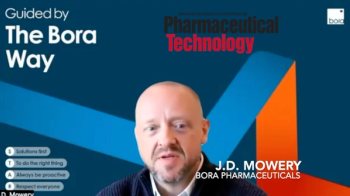
- Pharmaceutical Technology-10-02-2016
- Volume 40
- Issue 10
Defining Risk Assessment of Aseptic Processes
Susan Schniepp, distinguished fellow at Regulatory Compliance Associates, discusses the assessment of risk in the processing of intravenous injectable drugs.
Susan Schniepp, distinguished fellow at Regulatory Compliance Associates, discusses the assessment of risk in the processing of intravenous injectable drugs.
Q: I work in the quality group for a manufacturer who makes intravenous (IV) injectable drugs using aseptic processing techniques. Recently, the facility has experienced an increase in the number of viable organisms in our environmental monitoring program. Management has asked me to do a risk-based assessment so we can use our resources effectively. Can you offer some advice on how I should proceed in putting together this assessment?
A: Aseptic processing of IV injectable drugs is certainly one of the riskiest manufacturing operations. Your management is correct to be concerned when there is a reported increase in the number of viable organisms in the environment. It is often difficult to determine where a potential microbial ingress is coming from. This is why so much attention is given to monitoring personnel, equipment, air quality, etc., for microbial organisms and identifying and trending what those organisms are and where they are coming from. A risk-based approach to determine the source of the microbial increase is a good start. It is important to remember aseptic does not mean sterile and the objective in aseptic processing is to keep the product, components, and environment as close to sterile as possible. This is accomplished through proper building, equipment materials, and design; established and validated cleaning procedures; proper training for personnel; and continuous monitoring of the personnel and environment to make sure the sterile core area and the areas supporting it are properly maintained at all times to avoid product contamination that would impact patient safety.
Developing a risk-based approach
The first step in developing a risk-based approach for your facility is to break down your operations into the various steps and determine the highest risk posed to those areas. The highest risk areas tend to be those where personnel are intimately involved. Of these areas, one of the most risky is personnel gowning. Proper gowning is crucial to the aseptic operation because, in some cases, such as compounding pharmacies or manual fills for small clinical trial batches, it may be the only barrier between the product and the human. Because we can’t sterilize the human being, we must take care to make sure they understand the proper gowning technique and fastidiously adhere to it so the patient can be assured the product is safe.
Proper aseptic technique is critical to maintaining the sterile environment where the aseptic product will be filled. In September 2004, FDA finalized their guidance for industry titled Sterile Drug Products Produced by Aseptic Processing-Current Good Manufacturing Practice (1).
This document placed considerable emphasis on the training and behavior of the personnel involved in the aseptic fill operation. It is important for the company to continually focus on personnel behavior to avoid complacency and potential product risk. As stated in the guideline, “As operator activities increase in an aseptic processing operation, the risk to finished product sterility also increases. To ensure maintenance of product sterility, it is critical for operators involved in aseptic activities to use aseptic technique at all times.” To establish an operator’s skills, the company should have basic training topics covering personal hygiene, proper aseptic technique during operations and gowning activities, proper plating techniques for microbial monitoring, among others. In addition, the company should establish an ongoing training program as a way to maintain and continually improve the operators’ performance. This training should be documented by the quality department through training records, evaluation of the ability of the operator to follow standard operating procedures (SOPs), and monitoring deviations for breaches in aseptic technique during production. The concepts set forth in the FDA guideline are also set forth in the European regulations (2).
High-risk areas to assess
One of the most critical areas for establishing your risk assessment is the subject of proper gowning technique. If the operator can’t follow the proper gowning requirements, the product will be at risk the moment the operator enters into the critical manufacturing area. It is interesting to note that in a recent draft guidance issued for compounding facilities, the failure to properly gown is considered to be an insanitary condition (3).
Another discipline that should be considered as high risk in the risk assessment is cleaning. The cleaning of the line after manufacturing is personnel dependent and, if done incorrectly, can put the next product manufactured on the line at risk of microbial and/or cross contamination. There are many different disinfectant procedures, and it is important that they be executed effectively. Again, proper training and oversight should help maintain the employee’s skills, therefore avoiding potential product contamination.
Bottom-line, when establishing your risk-assessment program, some of the highest risk areas/activities will be those where there is a high level of human involvement. Assessing those areas first as contributing factors to your environmental problem will help you effectively manage your resources. But be advised that whatever the risk-ranking you give to each area/activity involved in your aseptic manufacturing each area must be thoroughly evaluated and vetted because any of the areas could be the potential source of your microbial problem.
References
1. FDA, Guidance for Industry, Sterile Drug Products Produced by Aseptic Processing-Current Good Manufacturing Practice (CDER, CBER, ORA, September 2004).
2. European Commission, EudraLex, Volume 4, Annex 1 (November 2008).
3. FDA, Draft Guidance for Industry, Insanitary Conditions at Compounding Facilities (CDER Office of Compliance, August 2016).
Article Details
Pharmaceutical Technology
Vol. 40, No. 10
Pages: 94, 92
Citation
When referring to this article, please cite it as S. Schniepp, "Defining Risk Assessment of Aseptic Processes," Pharmaceutical Technology 40 (10) 2016.
Articles in this issue
about 9 years ago
Improving Feeder Performance in Continuous Pharmaceutical Operationsabout 9 years ago
Protecting Parenterals in Primary Packagingabout 9 years ago
Manufacturers Face Major Changes under PDUFA VIabout 9 years ago
Fill/Finish Outsourcingabout 9 years ago
Calling All Authorsabout 9 years ago
Excipients for Formulation Successabout 9 years ago
Tracking a Global Problemabout 9 years ago
Chasing a Moving Target for Counterfeiting and Illegal DiversionNewsletter
Get the essential updates shaping the future of pharma manufacturing and compliance—subscribe today to Pharmaceutical Technology and never miss a breakthrough.





